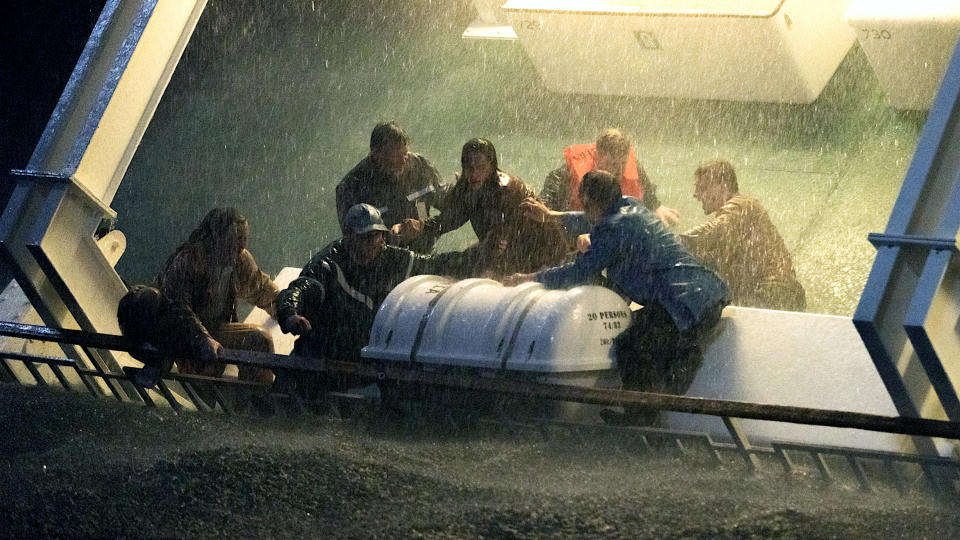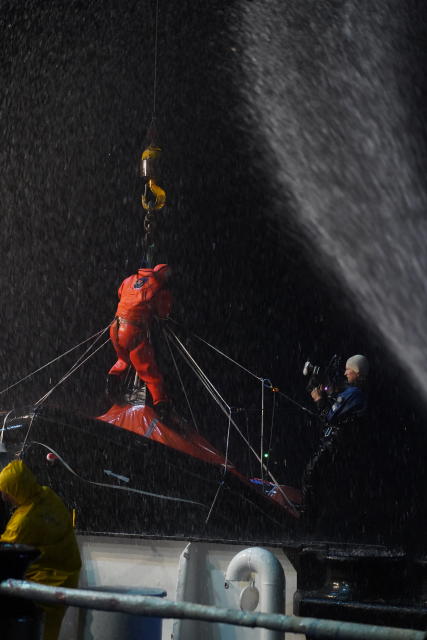Inside ‘Estonia,’ Beta’s Series About Europe’s Deadliest Maritime Disaster From the Creatives Behind ‘Chernobyl’ and ‘Bordertown’

It’s pitch dark and stormy and Pelle Heikkilä, one of Finland’s biggest stars, is getting slammed by massive waves in a 10-meter-deep water tank.
The shoot of “Estonia,” a Scandinavian limited series about Europe’s deadliest civil maritime disaster, is underway in Belgium at an indoor water stage. The eight-part cinematic show, which is budgeted at €15 million ($14.7 million) and is being shopped by Jan Mojto’s Beta Film (“Babylon Berlin”) at Mipcom, charts the sinking of the MS Estonia on Sept. 28, 1994, which killed over 850 people.
More from Variety
North Star Film Alliance Opens L.A. Office Led by Turner Pictures Vet Eleonora Granata
Eastern Europe Stays Upbeat About Return of TV and Film Production as Coronavirus Lockdowns Lift
The series is directed by Swedish director Måns Månsson (“The Real Estate,” “Chernobyl”) and Finnish director Juuso Syrjä (“Bordertown,” “Helsinki Syndrome”), who are polar opposites, one coming from festival-friendly auteur filmmaking, the other coming from high-end commercials.
Like the cast and crew of the series, the tragedy itself involved multiple countries, including Estonia, because it was an Estonian ship and departed from Tallinn; Sweden, because nearly half of the people who died in the shipwreck were Swedes; Finland, because the ship sinked in the Baltic sea near Finland; and finally, Germany, because the ferry was built by a West German shipyard.
Heikkilä (“Helsinky Syndrome,” “Invisible Heroes”) plays Ari Luoma-Aho, a Finnish rescue swimmer whose helicopter unit was the first one to arrive on the scene.
“I don’t have to act in there, I’m really trying to survive and save people. It’s like total chaos,” says Heikkilä, who admits that the role was different from any he’s played before because Luoma-Aho is still alive and isn’t a public figure.
“At first, Ari refused to be a part of this because he was skeptical about how it would be done, because he’s seen other TV series and movies about ‘Estonia’ and thought they were always done wrong and glorified the rescuers,” says Heikkilä, who stars alongside Doris Tislar, Katia Winter, Jussi Nikkilä, Peter Andersson and Arndt Schwering-Sohnrey.
“But when he read parts of the script, he said ‘I think you’re on to something. Like it’s close to the reality,'” he continues.
The immersive and subjective point of view of the series is precisely what Syrjä had in mind. “The camera is one of the characters and when we are in middle of this chaos, we push to be there, go in the middle of the accident, because we need to feel it and it’s handheld,” says Syrjä.
JP Passi, the Finnish cinematographer of “Estonia” who also worked on the Emmy- and BAFTA-winning mini-series “Chernobyl,” says he approached filming through thinking “how the scene was in reality, how it felt, looked – knowing that it was very, very dark.”
“They let us keep it as dark and as gritty and as crazy as we wanted to so that it feels that it’s the real thing and we’re in middle of everything,” says Passi, who collaborated on the series with VFX producer and supervisor Stefan Rycken and Dave Bannister.

On the set, Tislar, an Estonian actor, is also soaking wet, having completed underwater scenes for days. She plays Grete Kukk, an Estonian dancer who was meant to perform with her group on board on the MS Estonia and was one of the 138 people who survived. Grete almost drowned because she had put her life vest on backward and had to change rafts.
Tislar, who admits she wasn’t a good swimmer when she was cast and had to train every day for the role, also has a heavy heart when speaking about the project.
“It’s a series but we have to understand that it’s not entertainment, it’s not just another thriller action movie,” says Tislar. “It’s a real-life thing, and we have the responsibility of honoring the ones who didn’t survive, even if the focus is on the ones who did survive.”
It’s telling that “Estonia” re-teams Månsson and Passi, who previously worked together on “Chernobyl” which dramatized another European disaster, the 1986 explosion at the Nuclear Power Plant.
Månsson, who was a second-unit director on “Chernobyl,” says “Estonia” represents the biggest challenge he’s even taken on.
“I thought ‘Chernobyl’ was technically difficult, but this is way more complicated,” says Månsson. “It’s an ethical and moral minefield.”
While the sinking of the ship is an important part of the show, “Estonia” also spotlights the tentacular probe launched in the aftermath of the tragedy by the Joint Accident Investigation Committee established by Sweden, Estonia and Finland.
Showrunner Miikko Oikkonen (“Bordertown,” “Helsinki Syndrome”), who co-wrote the series with Olli Suitiala and Tuomas Hakola, says the starting point of the project was the fact that hundreds of testimonies of survivors and rescuers where finally unclassified.
“When I started to read the final report and went through the material, I realized the investigation itself was even more interesting than the accident,’ says Oikkonen. “It was a power play, a political game between these countries and it involved many conflicts of interests.”
The probe went on for nearly four years, and was deserted by all but one member, the young Henri Peltonen, who is one of the series’ protagonists. Inspired by a real character, Peltonen was determined to uncover the truth and penned the final report.
“The investigation was an equally horrible experience, and it was metaphorically also sinking. These two storylines are mirroring each other,” says showrunner Miikko Oikkonen (“Bordertown,” “Helsinki Syndrome”) who co-wrote the series with Olli Suitiala and Tuomas Hakola.
“When they started the investigation, they said that it is going to take two weeks, then maximum two months,” says Oikkonen. By the time the final report was published three and a half years later, five of the six-people on the board were gone – they either died or resigned.
With no one to blame, the disaster remained a sort of cold case which became, with time, almost taboo in Sweden, says Månsson.
Månsson says the impact on Swedish society was “massive” because the country “didn’t have any wars, and never had any disasters before… and all of the sudden, almost 500 Swedish people died and we were not ready for that.”
He says he finds the “lack of accountability” and the fact that “to this day no one knows what actually happened” frightening.
Månsson attribues the investigation’s lack of resolution to the Nordics’ conflict-averse attitude. “In so many other parts of the world, this would have gone to court, and would have been a legal battle,” says Månsson.
What the investigation did provide was “detailed information on what happened inside the ship, corridors, cabins and how people were feeling, because they interviewed survivors,” says Syrjä, adding that he used the wealth of intel to make it “as true as possible,” and also “fined-tuned” it “to make it more dramatic.”
Matti Halonen (“Bordertown”), who produced the series with Johannes Lassila (“Bordertown”) at Fisher King, the BETA-owned company behind “Nymphs” and “Bordertown,” says he and Oikkonen’s initial idea was to tackle the disaster like a “war trauma.” “I’ve made a couple war films and I see a lot of similarities in this kind of conflict,” says Halonen, who founded Fisher King with Oikkonen in 2013.
“When you have a war, no one wants to have it. It shouldn’t happen. We have all the same things here,” Halonen continues.
Justus Riesenkampff, executive chair of Beta Nordic Studios, which Fisher King is part of, says “Estonia” marked a milestone for the company and for Finland. “It’s a totally new level. ‘Estonia’ has a budget that’s three times higher than the average Finnish series,” says Riesenkampff.
The series was ordered by C More, TV4 and MTV3 Telia Estonia, and Beta already closed significant pre-sales, including Germany’s broadcaster SevenOne Entertainment Group, which bought “Chernobyl.” Fisher King produced the series with Swedish Kärnfilm AB, Andre Logié at Panache Production Belgium and Estonian Oü.

Best of Variety
The Best Pop Culture Halloween Costumes for 2022: From 'House of the Dragon' to 'Euphoria'
Constance Wu Gets Candid in Revealing New Memoir 'Making a Scene'
Sign up for Variety’s Newsletter. For the latest news, follow us on Facebook, Twitter, and Instagram.

